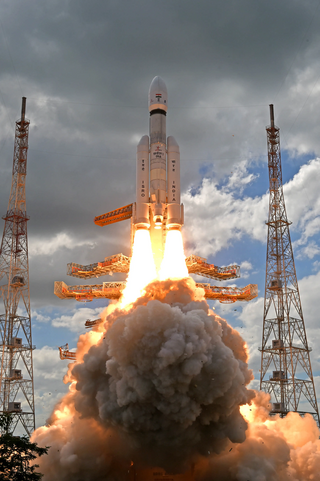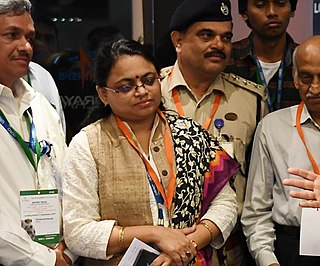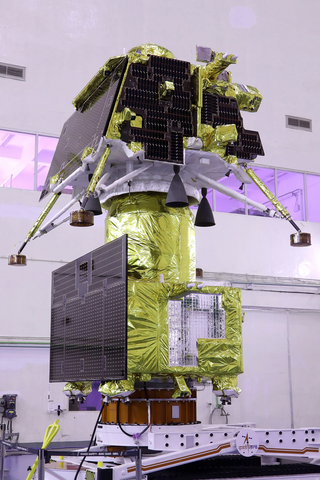| Names | MOM 2 |
|---|---|
| Mission type | Mars orbiter |
| Operator | ISRO |
| Mission duration | 1 year (proposed) |
| Spacecraft properties | |
| Bus | I-3K |
| Manufacturer | ISAC |
| Payload mass | ≈100 kg (220 lb) [1] [ needs update ] |
| Start of mission | |
| Launch date | TBD [2] [3] |
| Rocket | LVM3 [4] [2] |
| Launch site | SDSC/SHAR |
| Contractor | ISRO |
| Mars orbiter | |
| Orbital parameters | |
| Periareon altitude | 200 km (120 mi) [5] |
| Apoareon altitude | 2,000 km (1,200 mi) [5] |
Mars Orbiter Mission 2 (MOM 2), is a proposed second mission to Mars by the Indian Space Research Organisation (ISRO). [3] In a recorded interview in October 2019, the Vikram Sarabhai Space Centre (VSSC) director indicated the possibility of inclusion of a lander, [2] but in an interview to The Times Of India in February 2021 the ISRO chairman clarified that the mission will consist solely of an orbiter. [6] The orbiter will use aerobraking to lower its initial apoapsis and enter into an orbit more suitable for observations. [7] [8] [9]
Following the successful insertion of the Mars Orbiter Mission (also called Mangalyaan) into Martian orbit, ISRO announced its intent to launch a second mission to Mars at the Engineers Conclave conference held in Bengaluru on 28 October 2014. [10] The proposed launch vehicle for this campaign is the LVM3, which flew for the first time on 5 June 2017, and might be powerful enough to place MOM on a direct-to-Mars trajectory alongside much heavier satellites, unlike the lighter Mars Orbiter Mission, which used a less powerful PSLV XL rocket. [11]
In January 2016, India and France signed a letter of intent for ISRO and CNES to jointly build MOM 2 by 2020, [12] but by April 2018, France was not yet involved in the mission. [13] The Indian government funded MOM 2 in its 2017 budget proposal, and ISRO was considering whether the best path would be to conduct an orbiter/lander/rover mission or to opt for only an orbiter with more sophisticated instruments than those flown on MOM. [9] In a podcast recording, Vikram Sarabhai Space Centre director S. Somanath in October 2019 reported the architecture for mission was yet to be finalized and may also have a lander and rover, but no timeline was announced. [2]
In February 2021, ISRO called for an 'Announcement of Opportunities' on MOM 2. In it, K. Sivan announced that Mangalyaan 2 will only be an orbiter mission. [14] [15] Being launched by the LVM3 rocket ( formerly the GSLV mk III ), and using Aerobraking the MOM-2 satellite can carry more than 7 times the payload for MOM-1, also with a reduction in perigee to about 200 kms above the surface of Mars. [16]
An Announcement of Opportunity was released requesting submissions for scientific instruments for an orbiter only, with a deadline set for 20 September 2016. [17] [18] The total science payload mass is estimated at 100 kg (220 lb). [1]
One of the science payloads under development is an ionosphere plasma instrument named ARIS. It is being developed by Space Satellite Systems and Payloads Centre (SSPACE), which is part of the Indian Institute of Space Science and Technology (IIST). The engineering model and high vacuum test have been completed. [19]
In a panel discussion in September 2022, it was told that mission would include a hyperspectral camera, a very high resolution panchromatic camera and a radar to better understand the early stages of Mars, its early crust, recent basalts, and ongoing activities such as boulder falls. [20]
The mission will consist of four main payloads. [21]

The Polar Satellite Launch Vehicle (PSLV) is an expendable medium-lift launch vehicle designed and operated by the Indian Space Research Organisation (ISRO). It was developed to allow India to launch its Indian Remote Sensing (IRS) satellites into Sun-synchronous orbits, a service that was, until the advent of the PSLV in 1993, only commercially available from Russia. PSLV can also launch small size satellites into Geostationary Transfer Orbit (GTO).

The Indian Space Research Organisation is the national space agency of India. It operates as the primary research and development arm of the Department of Space (DoS), which is directly overseen by the Prime Minister of India while the Chairman of ISRO also acts as the executive of DoS. ISRO is primarily responsible for performing tasks related to space-based operations, space exploration, international space cooperation and the development of related technologies. ISRO is one of the six government space agencies in the world that possesses full launch capabilities, can deploy cryogenic engines, can launch extraterrestrial missions and operate a large fleet of artificial satellites. ISRO is one of the four government space agencies to have soft landing (unmanned) capabilities.

The Launch Vehicle Mark-3 or LVM3 is a three-stage medium-lift launch vehicle developed by the Indian Space Research Organisation (ISRO). Primarily designed to launch communication satellites into geostationary orbit, it is also due to launch crewed missions under the Indian Human Spaceflight Programme. LVM3 has a higher payload capacity than its predecessor, GSLV.

The Indian Human Spaceflight Programme (IHSP) is an ongoing programme by the Indian Space Research Organisation (ISRO) to develop the technology needed to launch crewed orbital spacecraft into low Earth orbit. Three uncrewed flights, named Gaganyaan-1, Gaganyaan-2 and Gaganyaan-3 are scheduled to launch in 2024, followed by crewed flight in 2024 on an LVM3 rocket.

Indian Deep Space Network (IDSN) is a network of large antennas and communication facilities operated by the Indian Space Research Organisation to support the interplanetary spacecraft missions of India. Its hub is located at Byalalu, Ramanagara in the state of Karnataka in India. It was built under the leadership of S K Shivakumar, the then ISTRAC Director and inaugurated on 17 October 2008 by the former ISRO chairman G. Madhavan Nair.

Chandrayaan-2 is the second lunar exploration mission developed by the Indian Space Research Organisation (ISRO) after Chandrayaan-1. It consists of a lunar orbiter, the Vikram lunar lander, and the Pragyan rover, all of which were developed in India. The main scientific objective is to map and study the variations in lunar surface composition, as well as the location and abundance of lunar water.

Koppillil Radhakrishnan is an Indian space scientist who headed the Indian Space Research Organisation (ISRO) between November 2009 and December 2014 as Chairman of Space Commission, Secretary of the Department of Space and Chairman of ISRO. Prior to this, he was the Director of Vikram Sarabhai Space Centre (2007-2009) and Director of National Remote Sensing Agency (2005-2008) of the Department of Space. He had a brief stint of five years (2000-2005) in the Ministry of Earth Sciences as Director of Indian National Centre for Ocean Information Services (INCOIS). Under his leadership of ISRO, India became the first country to reach Mars in its first attempt.

The Mars Orbiter Mission (MOM), unofficially known as Mangalyaan, was a space probe orbiting Mars since 24 September 2014. It was launched on 5 November 2013 by the Indian Space Research Organisation (ISRO). It was India's first interplanetary mission and it made ISRO the fourth space agency to achieve Mars orbit, after Roscosmos, NASA, and the European Space Agency. It made India the first Asian nation to reach the Martian orbit and the first nation in the world to do so on its maiden attempt.

The Chandrayaan programme also known as the Indian Lunar Exploration Programme is an ongoing series of outer space missions by the Indian Space Research Organization (ISRO) for the exploration of the Moon. The program incorporates a lunar orbiter, an impactor, a soft lander and a rover spacecraft.

Ritu Karidhal Srivastava is an Indian scientist and aerospace engineer working in the Indian Space Research Organisation (ISRO). She was a Deputy Operations Director to India's Mars orbital mission, Mangalyaan. She has been referred to as one of the many "Rocket Women" of India. Giving tribute to her excellence in Mangalayaan mission, a Bollywood film Mission Mangal was created where Indian actress Vidya Balan did her role.
Minal Rohit is an Indian scientist and systems engineer with the Indian Space Research Organisation (ISRO). She helped send the Mangalyaan space probe to Mars.

GSAT-29 is a high-throughput communication satellite developed by the Indian Space Research Organisation (ISRO). The mission aims at providing high-speed bandwidth to Village Resource Centres (VRC) in rural areas. The two Ku and Ka operational payloads will provide communication services to Jammu and Kashmir and Northeast India under Digital India programme. At the time of launch GSAT-29 was the heaviest satellite, weighing 3,423 kg (7,546 lb), that was placed in orbit by an Indian launch vehicle. Approved cost of GSAT-29 is ₹175.63 crore (US$22 million).
Moumita Dutta is an Indian Physicist working at the Space Applications Centre (SAC), Indian Space Research Organisation (ISRO) - Ahmedabad, as a scientist/engineer. She has expertise in the development and testing of the Optical and IR sensors/instruments/payloads. She was part of the team Mars Orbiter Mission (MOM) to put a probe into orbit around Mars in 2014. She contributed significantly in the development of one of the five payloads of MOM.

The Human Space Flight Centre (HSFC) is a body under the Indian Space Research Organisation (ISRO) to coordinate the Indian Human Spaceflight Programme. The agency will be responsible for implementation of the Gaganyaan project. The first crewed flight is planned for 2024 on a home-grown LVM3 rocket.

Chandrayaan-3 is the third mission in the Chandrayaan programme, a series of lunar-exploration missions developed by the Indian Space Research Organisation (ISRO). The mission consists of a Vikram lunar lander and a Pragyan lunar rover similar to those launched aboard Chandrayaan-2 in 2019, as well as a propulsion module that carried the spacecraft from Earth orbit to lunar orbit.

The Indian Mars exploration missions are an ongoing series of outer space missions by the Indian Space Research Organisation (ISRO) for the exploration of Mars. The exploration is currently in the primary phase with Orbiter missions.
The Venus Orbiter Mission, unofficially known as Shukrayaan, is a planned Indian Space Research Organisation (ISRO) mission to study the surface and atmosphere of Venus.
{{cite conference}}: CS1 maint: unfit URL (link)